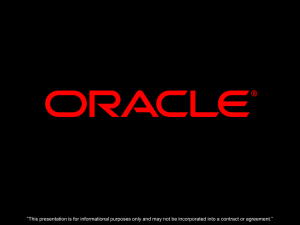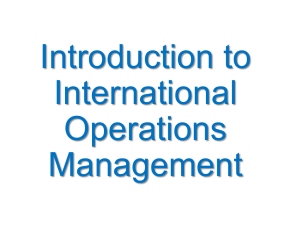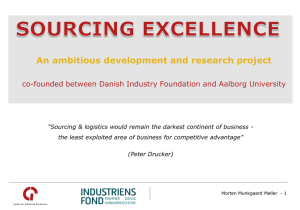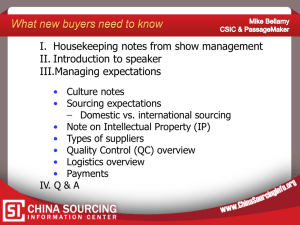(I) What is global sourcing?
advertisement
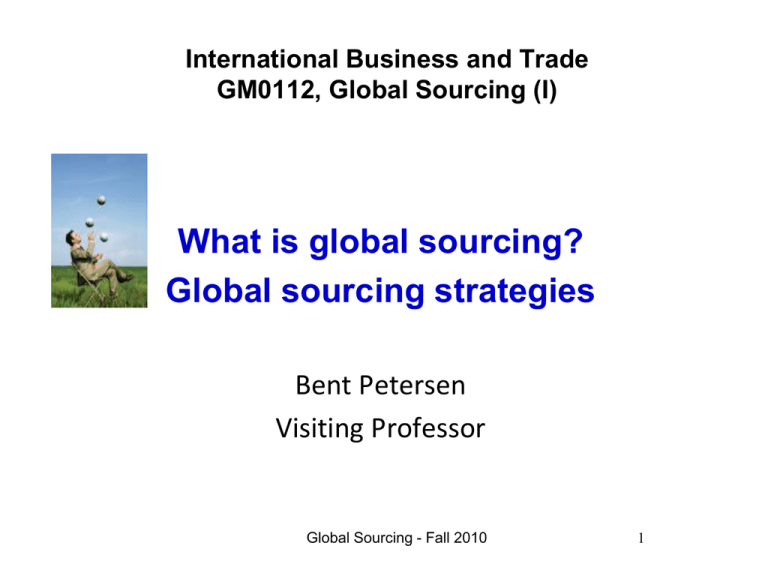
International Business and Trade GM0112, Global Sourcing (I) What is global sourcing? Global sourcing strategies Bent Petersen Visiting Professor Global Sourcing - Fall 2010 1 Contents of today’s lecture 1. What is global sourcing? 2. Overview and trends of global sourcing 3. Global sourcing choices and strategies: – The WHAT question – The WHERE question – The HOW question Global Sourcing - Fall 2010 2 What is global sourcing? Global Sourcing - Fall 2010 3 What is global sourcing? A very broad definition includes import and foreign sourcing for local use. However, for this course we suggest a narrower definition: Firms’ use of foreign resources for global use. Global sourcing level V (Trent & Moncka, 2005): Integrated and coordinated sourcing, not only among worldwide buying locations, but also across functional groups (such as R&D, operations and marketing). Global Sourcing - Fall 2010 4 Global sourcing and Dunning’s FDI motives Global sourcing is not market seeking or horizontally organized subsidiaries... ...but may include: Resource seeking Efficiency seeking Strategic asset seeking (Dunning, 1980 & 1993) Global Sourcing - Fall 2010 5 Global sourcing – of which activities? For many activities - such as day care, nursing, transportation, gardening - global sourcing is not feasible at all; these activities are inherently local activities. However, all goods and services that can be transported or transmitted (digitization!) at reasonable costs are amenable to global sourcing. Global Sourcing - Fall 2010 6 A value chain approach Presumably, MNC managers consider global sourcing in relation to individual value added activities. Michael Porter’s value chain includes 9 distinct business activities that may differ significantly in terms of scale and scope economies, transaction costs/risks, resource requirements, and strategic importance. Global Sourcing - Fall 2010 7 Value Creation Logics Not one generic, but several business sector specific value creation logics: The value chain of manufacturing firms (Porter, 1985). The value shop of consulting firms (Stabell and Fjeldstad, 1998). The value network of banks and telecommunication firms (Stabell & Fjeldstad, 1998). Global Sourcing - Fall 2010 8 A value chain (Porter, 1985): SUPPORT ACTIVITIES PRIMARY ACTIVITIES Global Sourcing - Fall 2010 9 Dispersed value chain configuration (“multi-domestic MNC”) Sweden (HQ) Sales US Subsidiary Sales Germany Denmark Global Sourcing - Fall 2010 10 Concentrated value chain configuration (“globally integrated MNC”) Denmark Sweden HRM Norway M&S R&D Manufacturing IT India Global Sourcing - Fall 2010 China 11 Concentrated value chain configuration precipitates an integrated network (Bartlett & Ghoshal, 1989) Global Sourcing - Fall 2010 12 Some company examples… ….of mainly dispersed value chain configuration Carlsberg Isover Ikea … of mainly concentrated configuration Logitech Inc GN Resound Global Sourcing - Fall 2010 13 GN ReSound’s concentrated value chain configuration Cork: Distribution and production. København: Headquarter. R&D, Brand development and production. Bloomington: Administration, distribution, sales and marketing Chicago: Salg og marketing, and R&D. Xiamen: Production (largest factory). Global Sourcing - Fall 2010 14 Sourcing globallocs.jpg (onshore-offshore) Location Home country Foreign country Onshore sourcing FDI /Captive offshoring Operator Ourselves J/V Contractual Partner Onshore outsourcing Global Sourcing - Fall 2010 Offshore outsourcing 15 Global sourcing: Overview and trends Global Sourcing - Fall 2010 16 Offshoring of services– Global trends Number of service jobs worldwide: 1.46 mia Number of service jobs that theoretically can be carried out as remote services: 160 mio Offshored jobs until 2003: 1.5 mio In 2003 US and UK firms represented around 70% of all offshored service activities. India’s world market share of ”Business Process Offshoring” (including IT) is almost 50 %. Global Sourcing - Fall 2010 Source: McKinsey Global17 Institute, 2005 Offshoring – Global trends Global Sourcing - Fall 2010 18 What Drives Firms’ Global Sourcing? Improved transportation technology (reversed by increasing energy prices) Advances of IT (digitization!) Market integration (lower trade barriers and FDI restrictions) Product modularization techniques Increased global competition Improved market institutions, such as: Intellectual property right protection Industry standards Certification, accreditation October 4 Global Sourcing - Fall 2010 19 Coordination of value chain activities Porter’s (1986) global value chain framework High Shrinking factor cost differentials Lower coordination (I&CT) and transportation costs Low Market Integration Dispersed Oc Concentrated Global Sourcing - Fall 2010 Configuration of value chain activities 20 Resource commitment to foreign sales effort (The Establishment Chain phenomenon) Equity (FDI) Contractual (outsourcing) Value chain specialization (Global sourcing) High (concentrated configuration / extensive coordination) Arm’s length (procurement) Low (dispersed configuration / sparse coordination) Local Regional Global Sourcing - Fall 2010 Global Geographical expansion of sales (The Psychic Distance phenomenon) 21 Re-Configuring the Value Chain MNCs are in the process of a dual transformation of their value chains: 1. A surge from dispersed to concentrated configuration strategies in which global sourcing plays a vital role. 2. A surge in direction of a more fragmented and modularized value chain in which offshore outsourcing plays a prominent role. Global Sourcing - Fall 2010 22 Typical US TNC re-configuration pattern 0. Point Zero: Dispersed, un-coordinated TNC units. 1. Establishment of (regional) Shared Services Centers Consolidation in terms of scale economies and transparent cost structures. 2. Fragmentation and modularization of value chain activities. 3. Decision about location (on/near/off-shore?) and ownership (captive/JV/outsourced?). Global Sourcing - Fall 2010 23 TNC example: American Express 1990s: 46 sites carrying out travel related services. – Process duplication and inconsistencies – Lack of customer focus – Inflexible, legacy applications 1993: 3 regional shared services centers in Phoenix USA, Brighton UK, Gurgaon India. 2000s: The Indian captive center provides services to Amex units outside Asia, thereby becoming a global sourcing center. Global Sourcing - Fall 2010 24 Global sourcing choices and strategies: The What, Where and How questions Global Sourcing - Fall 2010 25 The WHAT question What should be sourced locally - and what in central hubs serving the MNC as a whole? Which value chain activities should remain in the home country and which should be relocated to foreign destinations? Theory, literature streams: RBP, open sourcing/innovation literature, information economics. Global Sourcing - Fall 2010 26 The WHERE question Where should value chain activities that cannot be retained (or developed) economically in the home country be moved to? Closely related to the question of partner selection. Theory: Economic geography (including global SCM/logistics and agglomeration economies), institutional theory. Global Sourcing - Fall 2010 27 The HOW question How to organize the re-location? What should be the governance structure of value added activities (re-)located abroad? Make-or-buy? JV? Theory/literature streams: TCEs, organizational learning literature Global Sourcing - Fall 2010 28 Example: Different business models of the Danish apparel industry Global Sourcing - Fall 2010 29


